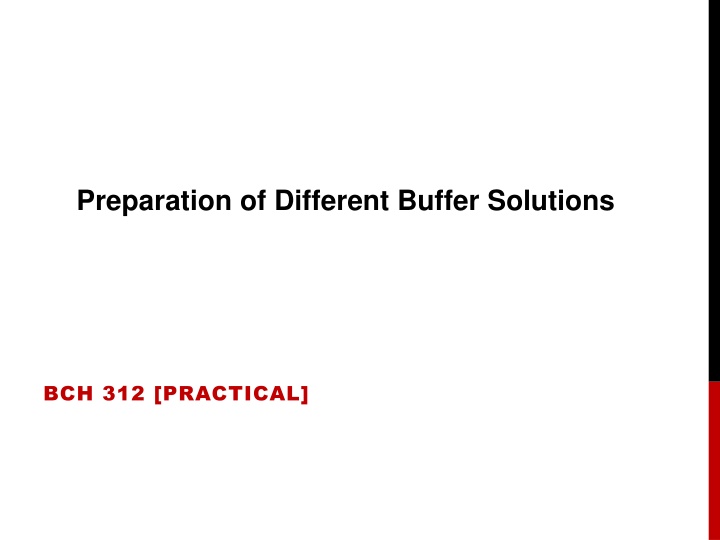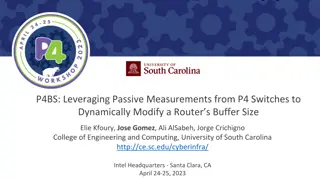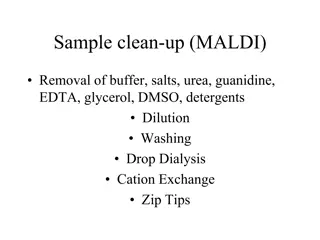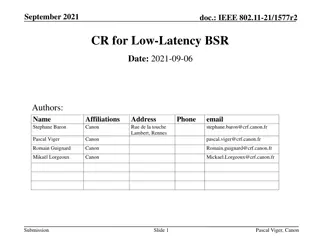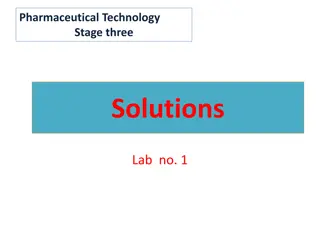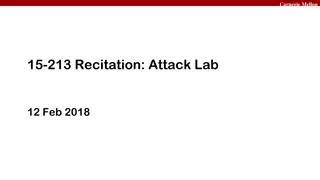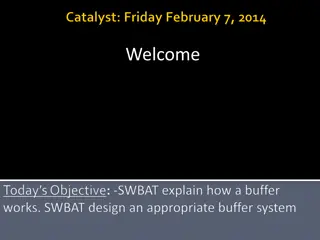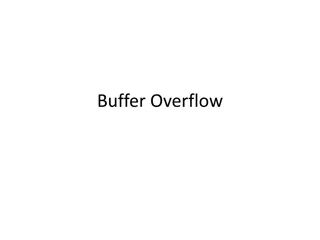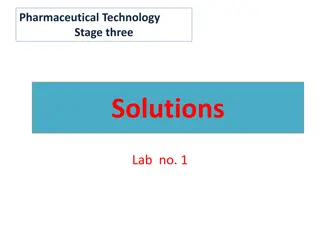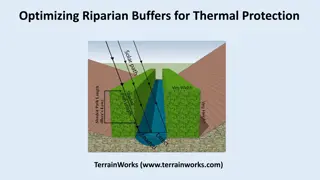Preparation of Different Buffer Solutions
Dive into the practical aspects of preparing different buffer solutions in the BCH 312 lab. Understand the importance of buffering systems and learn the techniques involved in creating these solutions. This hands-on experience will enhance your understanding of buffer chemistry and its applications in various fields of science.
Download Presentation

Please find below an Image/Link to download the presentation.
The content on the website is provided AS IS for your information and personal use only. It may not be sold, licensed, or shared on other websites without obtaining consent from the author.If you encounter any issues during the download, it is possible that the publisher has removed the file from their server.
You are allowed to download the files provided on this website for personal or commercial use, subject to the condition that they are used lawfully. All files are the property of their respective owners.
The content on the website is provided AS IS for your information and personal use only. It may not be sold, licensed, or shared on other websites without obtaining consent from the author.
E N D
Presentation Transcript
Preparation of Different Buffer Solutions BCH 312 [PRACTICAL]
Objective: 1) To understand the nature of buffers solutions. 2) To learn how to prepare buffers.
Introduction: All biochemical reactions occur under strict conditions of the concentration of hydrogen ion. Biological life cannot withstand large changes in hydrogen ion concentrations which we measure as the pH. -Those solutions that have the ability to resist changes in pH upon the addition of limited amounts of acid or base are called Buffers.
Buffers are, -Those solutions that have the ability to resist changes in pH. upon the addition of limited amounts of acid or base. -A buffer is made up of, (types of buffer): 1- a weak acid and its conjugate base(its salt) Acidic Buffer 2- Or a weak base and its conjugate acid (its salt) Basic Buffer
Types of Buffer Examples: 1-Weak acid and its conjugated base[ its salt] [acidic buffer] Example: 1. CH3COOH / CH3COONa (Pka) CH3COOH (Weak acid) CH3COONa (conjugated base its salt-) 2. NaH2PO4/ Na2HPO4(Pka) 3. ( HCO3Na / H2CO3) (Pka) 2- Weak base and its conjugated acid [ its salt] [basic buffer] Example: (NH3/NH4Cl) (Pkb) NH3(Weak base) NH4Cl (conjugated acid its salt-)
Mechanism of Action (Buffer): Example using [HA/A-] as buffer . HA: Weak acid. A-: conjugated base [its salt]. a] If H+ is added to this buffer system H+ will react with conjugated base to give conjugate acid. H+ A- HA A-: conjugated base (salt). HA: conjugate acid. b) If OH- is added to this buffer system [HA/A-] OH will react with conjugated acid to give conjugate base and H2O. HA A- +H2O OH- HA: conjugated acid. A-: conjugated base (salt).
Mechanism of Action (Buffer): Example: CH3COOH / CH3COO- -When acid added CH3COO- + H+ CH3COOH -When base added CH3COOH + OH - CH3COO- + H2O NOTE: It resists pH changes when it s two components are present in specific proportions Thus a buffer can protect against pH changes from added H+ or OH- ion as long as there is sufficient basic and acidic forms respectively. As soon as you run out of one of the forms you no longer have a buffer
-The Henderson-Hasselbalch equation, is an equation that is often used to: 1- To calculate the PH of the Buffer. 2-To preparation of Buffer. -It relates the Ka [dissociation constant] of a weak acid , [HA] concentration Of weak acid component , [A-] concentration Of conjugate base [salt of the weak acid] component and the pH of the buffer. The equation is derived from the acid dissociation constant. Note: Ka is weak acid dissociation constant
-This equation is derived from acid dissociation constant: Ka=?+ [? ] [??] -A buffer is best used close to its pKa.[to act as a good buffer the pH of the solution must be within one pH unit of the pKa].
Calculating the PH values : 1- For weak acid [not buffers]: Pka + P[HA] 2 PH = * P[HA] = -log [HA] 2- For weak base [not buffers] : Pkb + P[OH] 2 POH = Then , PH = Pkw POH. Pkw : number of dissociation constant of H2O.
3-For buffers Henderson-Hasselbalch equation
1) Nature of buffers: -You are provided with: 0.2M solution of CH3COOH, 0.2M solution of CH3COONa. -Calculate the volume that you must take from CH3COOH and CH3COONa, With (the final volume of the solution =20 ml) and pKa of CH3COOH = 4.76 The Add 0.1 ml Measure pH HA A- Final vol. CALCULA TED MEAURED SOLUTION difference [CH3COO H] [CH3COO Na] pH 2M Hcl [ml] pH ml ml 0.1 100%HA 20 ml 0 20 ml 2.729 0.1 75%HA, 25%A- 15 ml 5 ml 20 ml 4.28 0.1 50%HA, 50%A- 10 ml 10 ml 20 ml 4.76 0.1 25%HA, 75%A- 5 ml 15 ml 20 ml 5.24
Total volume of mixture is 20 ml So, 1. To Calculate the volume that you must take from CH3COOH and CH3COONa to prepare, 100% HA in total volume of 20 ml : = (20 x 100)/100 = 20 ml So, take 20ml HA and measure the PH. 2. To Calculate the volume that you must take from CH3COOH and CH3COONa to prepare, 75%HA, 25%A- in total volume of 20 ml : From HA= (75 x 20) /100 = 15 ml From A- = (25 x 20)/ 100 = 5 ml Mix 15ml HA and 5 ml A- and measure the PH (measured PH) note that the total volume is 20 ml [15ml +5ml =20ml] HA : as CH3COOH. A-: as CH3COONa.
Calculated PH ( table cont.) : ** 75%HA , 25% A- PH = Pka + log [A-]/[HA] PH= 4.76 + log [A-]/[HA] [HA] = C1 X V1 = C2 X V2 = 0.2 X 15 = C2 X 20 C2 = 0.15M ** 100% HA : Pka + P[HA] 2 PH = 1st: P[HA] = - log [HA] = -log 0.2 = 0.698 2nd: PH= [A-] = C1 X V1 = C2 X V2 = 0.2 X 5 = C2 X 20 C2 = 0.05 M So, PH = 4.76+log 0.05/0.15 PH = 4.282 4.76+ 0.698 2 PH = 2.72
50%[HA] , 50%[A] PH= 4.76 + log [A-]/[HA] [HA] = 0.2 X 10 = C2 X 20 C2 = 0.1 M [A-] = 0.2 X 10 = C2 X 20 C2 = 0.1 M So, PH = 4.76 + log 0.1/0.1 PH = 4.76 + 0 PH = Pka
(2)Preparation of buffer: You are provided with 0.2M acetic acid and solid sodium acetate , (pKa=4.76).Prepare 50 ml of a 0.19M acetate buffer pH =4.86. Calculations:- -Solid sodium acetate [as A-] - 0.2M Acetic acid. [as HA] - Pka = 4.76 - buffer pH=4.86 Provided -Final volume of buffer =50ml -Buffer concentration = 0.19 M Buffer Concentration = [HA] + [A-] Required 0.19 =[HA] + [A-]
PH = Pka +log [A-] \[HA] Assume [A-] =y , [HA] = 0.19 y y 4.86 = 4.76 +log 0.19-y y 0.1 = log 0.19-y -by taking the Anti log for both sides : y 1.26 = 0.19-y y=1.26 x (0.19-y) y= 0.24 1.26 y y + 1.26 y = 0.24 y= 0.11 M [which is the concentration of [A-] in the buffer] So, [HA] = 0.19 0.11 = 0.08 M [which is the concentration of [HA] in the buffer] =0.19
- To calculate the volume needed from [HA] to prepare the buffer, No. of mole of [HA] should be calculated first : No. of mole = Molarity x Volume of solution in L =0.08 X 0.05 = 0.004 mole So, M of stock = no. of mole / Volume in Liter 0.2 = 0.004 / V V = 0.02 L = 20 ml - To calculate the weight needed from [A-] to prepare the buffer, No. of mole of [A- ] should be calculated first : No. of mole = 0.11 X 0.05 = 0.0055 mole wt (g) of [A-] = (0.0055) x 82 = 0.451 g Now take 20 ml from 0.2M acetic acid and 0.451 g from Solid sodium acetate and complete volume to 50 ml H2O. (0.19 M acetate buffer)
: (3)Testing for buffering behavior For the 0.19M acetate buffer prepare: Solution (10 ml of Measured pH Add 2M HCl Measured pH after each) HCl addition 0.19M acetate buffer. 0.1 ml o.2M KCl. 0.1 ml
